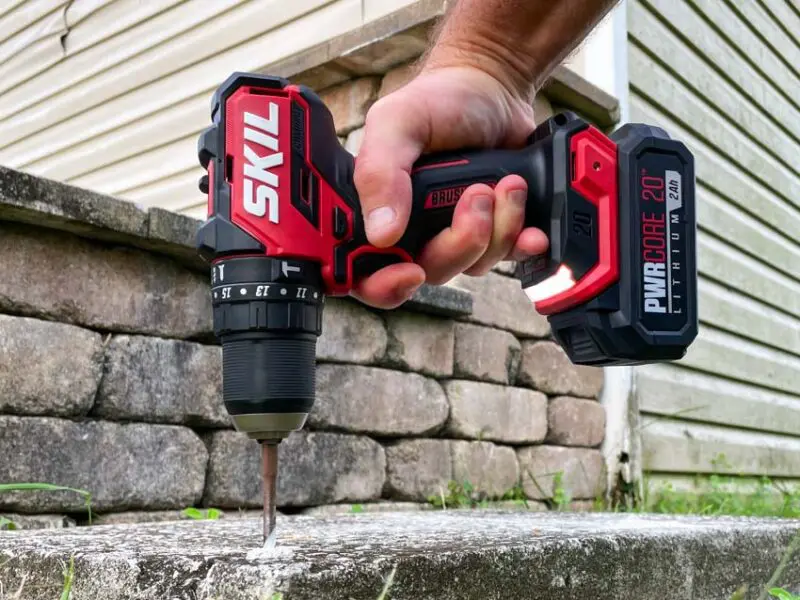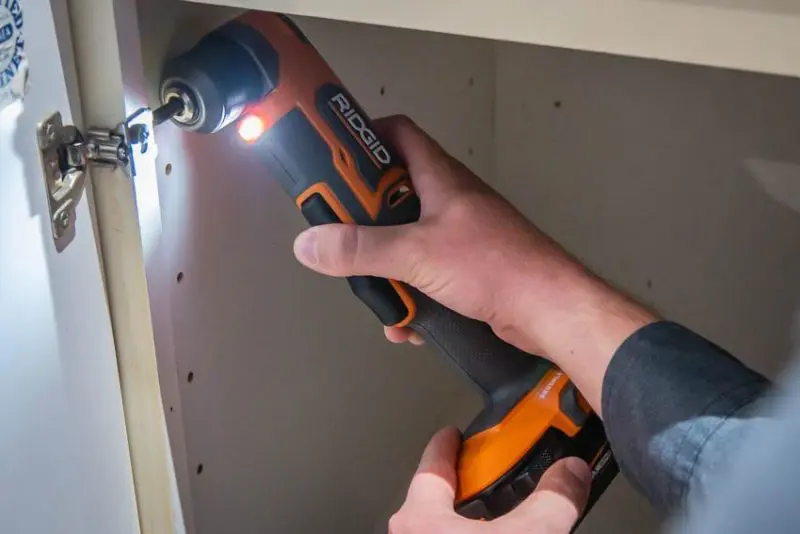One of the first power tools people start with is a drill. Even the most seasoned Pros had to learn how to use a drill at some point, and I’m going to help you get over the initial learning curve in this article.
The vast majority of drills on the market are cordless battery-powered models, but these same concepts apply to corded models as well.
Jump To…
- Types of Cordless Drills
- Get to Know Your Cordless Drill
- How to Use a Cordless Drill to Make Holes
- How to Use a Cordless Drill to Drive Screws
- How to Select the Right Drill or Driver Bit
- Safety Tips
Ready to shop? Check out our Best Cordless Drill recommendations!
Types of Cordless Drills
Cordless Screwdriver
Cordless screwdrivers spin bits at relatively slow speeds and low torque and aren’t technically a type of drill even though they spin a bit in a similar manner. Their name gives away their function—these tools are for driving small screws, but not drilling holes.
Drill Driver

Most cordless drills you see fall into the class of drill drivers—tools with settings for both drilling holes and driving screws.
Hammer Drill/Hammer Drill Driver

A hammer drill, or hammer drill driver, adds an extra chipping mode to a standard drill driver, helping it work more effectively into concrete and masonry.
For professional and some prosumer brands, their flagship drill drivers often have a hammer drill version as well. They typically have the exact same performance—one just has the hammer mode and the other doesn’t.
Right Angle Drill

A right angle drill is an elongated form of a drill driver that has a very short head to reach into tighter spaces than standard models can. The performance level is lower, but the design makes it a good secondary option for remodelers, HVAC techs, electricians, plumbers, and other tradesmen.
A much stronger version of the right angle drill—often known as a Hole Hawg after Milwaukee’s design—is specifically geared for the high-torque hole drilling required for rough-ins.
Rotary Hammer

Most people don’t consider a rotary hammer to be a type of drill, but they are used for drilling applications extensively in the concrete industry.
These are much larger than standard models and have modes for making larger holes in concrete and chipping to break it apart. Some models also include a rotation only mode for drilling in wood or metal.
Get To Know Your Cordless Drill

If you’re new to cordless drills, there are some terms and parts you should know. Here’s a basic overview, starting at the business end and working back.
Chuck

This is the part that holds your bit in place. Most modern drills have a “keyless” chuck, meaning you only need the strength of your hand to secure the bit in place.
How to Install and Change Drill Bits
- With the tool pointing away from you, clockwise rotation loosens and counterclockwise tightens the chuck
- Tight or loosen the chuck until the bit can slide in but doesn’t slip between the teeth
- Tighten the chuck until the bit is secure—you’ll feel and hear the chuck ratchet as the teeth bite down
- Pull the trigger and check to see that the bit is spinning straight—reinstall it if it’s not
- To remove a bit, turn the chuck clockwise until it releases
Pro Tip: A small amount of bit wobble (called runout) is normal. However, a big wobble means your bit is off-center. Loosen the chuck, re-center the bit, and tighten it back down to fix it.
Mode Selection/Clutch Collar
Many drills have more than one mode you can work in. By twisting a collar behind the chuck, you can adjust the clutch settings or twist it all the around to the drilling mode. Hammer drills have a third mode that engages the hammering mechanism.
The clutch limits how much torque goes into the bit. It’s useful when you’re working with smaller screws and want to avoid driving them too deep into the material or stripping out the heads (AKA cam out).
How to Use the Clutch
- Select some scrap material to experiment with that matches your workpiece materials
- Starting with a low clutch setting, drive a screw into the material and see how deep it sinks
- Increase the clutch a little at a time until you get the depth you want
- Try several more screws to ensure you’re getting consistent results
- Note which settings work best with each material type and screw size to save time on future projects
Pro Tip: Some materials have highly variable density, and a single clutch setting doesn’t work for all the screws. Many people find it easier to feather the trigger instead of constantly adjusting the clutch in those scenarios.
Gearbox Switch

For most cordless drills, the gearbox switch sits on top of the housing. This physically changes the gear to prioritize either speed or torque. On a two-speed model, gear one is low speed/high torque and gear two is high speed/low torque.
How to Change Gears
- Push the gear switch to the mode you want to use
- The gear number is either printed on the housing or inset on the switch itself
Pro Tip: There’s an inverse relationship between speed and torque on a drill. When you select a gear with higher speed, it has less torque. In a gear with lower speed, it has higher torque.
Forward/Reverse Switch

Just above the trigger is the switch for forward and reverse. Its position makes it easy to flip while you have a natural grip on the handle.
How to Change Between Forward and Reverse
- Grip the tool by the handle with one hand and support the chuck end with your other
- Using either your thumb or forefinger, push the switch to the left for forward or the right for reverse
- Push the switch to the center position between forward and reverse to lock out the trigger.
Variable Speed Trigger
Nearly every cordless drill has a variable speed trigger. This means the further you pull the trigger, the more speed and torque the motor sends to the bit, similar to the way a gas pedal works on your vehicle.
Even though you might only have two gears, you can use a partial trigger pull (“feathering” the trigger) to operate at slower speeds and with less torque or to accelerate into drilling/driving with more control.
How to Use the Trigger
- Pull the trigger all the way in to get the maximum speed and torque for the gear you’re using
- Slowly pull the trigger further in for a slower acceleration that offers more control at the start of your drilling or driving
- Use a partial trigger pull (called “feathering”) to intentionally keep the speed and torque down for precision control or delicate materials
How to Use a Drill to Make a Hole
- Mark where you want to make the hole
- Install the bit you want to use
- Select drill mode (or hammer drill mode if you’re working in concrete)
- Place the point of the bit in the center of your mark
- Make sure the bit is angled straight into your material
- Pull the trigger and apply pressure to help work forward into the hole
- Once the hole is complete, switch the motor to reverse, pull the trigger, and back the bit out
Tips for Success
- Start slow to prevent the bit from moving off of your mark (called bit “walking”)
- Use a jig to make accurate holes at an angle
- Use a few drops of oil when you’re drilling in metal
- For pilot holes, select a twist bit that’s the same diameter as the shank of the screw you’re driving
How to Use a Drill to Drive Screws
- Mark where you want to install the screw
- Drill a pilot hole (if necessary)
- Install the driver bit that matches the type of screw you’re installing
- Set the clutch to drive the depth you want
- Pull the trigger to drive the screw
Tips for Success
- Feather the trigger instead of using the clutch in material with high density variance
- Drill a pilot hole when working with hardwoods, using large screws, or driving close to the edges of wood to prevent splitting the material
- Use self-tapping screws to avoid having to make pilot holes in metal
- Start slow to prevent the screw tip from walking and feather the trigger to accelerate into the drive
How to Select the Right Drill or Driver Bit
Selecting the proper bit to use is all about understanding the size of the hole you’re making and the material you’re making it in. Here’s a quick overview of the most common drilling and driving bits, along with the materials they’re best in.
Twist Bits
What most people think of when they say “drill bit” is the classic twist bit. Their slender shafts with dual flutes for channeling away material are responsible for making smaller holes in a variety of materials.
- Size Range: ~ 1/32 – 1/2 an inch (also available in metric sizes)
- Black Oxide Coated Bits: Good, inexpensive option for wood, plastic, and mild steel
- Titanium Coated Bits: Excellent mid-priced all-around bit for wood, plastic, mild steel, and stainless steel
- Cobalt Bits: Best all-around for metal but usually reserved for hardened steel due to high cost
- Carbide Bits: Best for concrete and masonry
Need a recommendation? Check out our best drill bit picks or hit the button below to get my go-to set!
Spade Bits
Spade bits (AKA paddle bits) have a narrow tip to start the hole and broad cutting edges that make it larger. These bits are primarily for making holes in wood only.
- Size Range: 1/8 – 1 1/2 inches
- Spade Bits w/ Self-feeding Tips: The tip automatically feeds the bit through wood, making it easier to use and more efficient
- Nail Strike Spade Bits: Have a more robust design to cut through nails when hitting them is a risk
Click the button below for a solid spade bit set to get you started!
Hole Saws
Hole saws are for drilling some of the largest holes in a variety of materials. The saw portion looks like a cup and has teeth around the edge that cut out a core to make the hole. The cup attaches to an arbor that installs into the chuck.
- Size Range: 1/2 – 6 inches
- Bi-Metal Hole Saws: Least expensive option that’s good for wood, metal, or drywall
- Carbide Wood Hole Saws: Long-life option that can handle occasional nail strikes
- Carbide Metal Hole Saws: Specifically designed for long life when working with metal
Pro Tip: Hole saw arbors normally only fit in drills with a 1/2-inch chuck. If yours has a 3/8-inch chuck, a hole saw won’t work with it.
Many people buy hole saws individually to fit the needs of the project. If you’re looking for something to get you going, click the button for a solid starter set.
Driver Bits
Driver bits are what you use when you’re driving screws, and there are just as many options as there are screw head types. The key is to match the driver bit to the head type and size. Size is important. If the bit is too small for the head, it will start to spin and cam it out quickly. If it’s too large, it won’t grip at all or will have a weak grip that also leads to cam out.
Here are some common types of driver bits:
- Slotted
- Phillips
- Square
- Hex
- Torx (Star)
- Nut Drivers and Socket Adapters
Pro Tip: Keep several sizes of driver bit extenders handy. Short ones are good for regular use and longer ones can reach into tight spots that are too small for the tool to fit into.
Click the button for an excellent driver set to keep on hand for a variety of projects.
Other Types of Drill Bits
The bits above don’t cover every situation, and there may be others that can help you do the job more effectively plus tons of specialty bits. Here’s are a few more Pros often use that you might find helpful:
- Step Bits: Each step opens the hole more as you punch through metal
- Auger Bits: Combination of a spade bit and twist bit for wood, often used for rough-ins or utility installation
- Self-feed Bits: Similar function to a hole saw for wood, but shaves out all the material instead of a cutting out a core
How to Use a Drill Safely
- Wear safety glasses every time—two eyes are better than one… or none
- Don’t use bit sizes outside the recommended range (find it in the manual)
- Use two hands whenever possible for better control and lower injury risk
- Use the side handle for large bits and fasteners if your drill came with one
- Know what’s behind the drywall before putting a hole in it—you really don’t want to send a bit through wiring or plumbing
- If the outside of the tool or the battery gets hot, give it a rest to avoid burning up the motor or damaging the battery cells
- Silicosis sucks, so consider wearing a respirator when you’re working with concrete or other masonry



